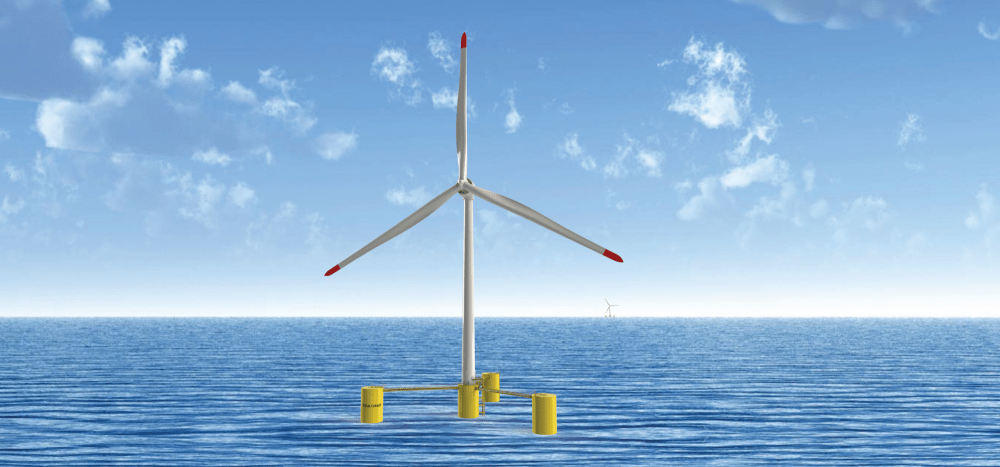
VolturnUS passes ABS review
ABS review demonstrates feasibility of semisubmersible foundation concept for floating offshore wind turbines
 Orono, Maine – The American Bureau of Shipping (ABS), a leading provider of classification and technical services to the offshore and marine industries, has completed the design review of the Front End Engineering and Design (FEED) documentation for the VolturnUS, a floating offshore wind turbine (FOWT), developed by the University of Maine Advanced Structures and Composites Center.
Orono, Maine – The American Bureau of Shipping (ABS), a leading provider of classification and technical services to the offshore and marine industries, has completed the design review of the Front End Engineering and Design (FEED) documentation for the VolturnUS, a floating offshore wind turbine (FOWT), developed by the University of Maine Advanced Structures and Composites Center.
“UMaine is pleased that its innovative design became the first floating wind turbine concrete semisubmersible hull to be reviewed by ABS, and found to meet the ABS requirements,” said Dr. Habib J. Dagher, P.E., UMaine Composites Center executive director and principal investigator.
“After 10 years of development, this is a major milestone for our program, and we expect the VolturnUS hull concept to continue to attract private investment from the U.S. and around the world. Nearly 70 percent of the U.S. offshore wind resources can be captured using the UMaine VolturnUS technology, and we are looking forward to working with offshore wind developers across the U.S.”
The patented VolturnUS, developed by the UMaine Advanced Structures and Composites Center is based on a concrete four-column semi-submersible hull concept.
In 2013, the UMaine team successfully tested the feasibility of the concept by developing a 1:8 scale model and deploying it in Castine, Maine. Maine Aqua Ventus I, GP, LLC, is now leading a full-scale, two turbine demonstration project called New England Aqua Ventus I, a 12 megawatt (MW) floating offshore wind pilot project to develop a clean, renewable energy source off Maine’s shores. This pilot project will demonstrate the innovative VolturnUS at full-scale as a viable and economical alternative for offshore wind developments in water depths greater than 50 meters.
“ABS has been the leading classification organization for the offshore industry from the very beginning of offshore operations, and we are pleased that the renewable energy industry is now looking to ABS for FOWT design review,” said ABS Executive Vice President for Global Offshore Ken Richardson.
“ABS was the first classification organization to work offshore and continues to be a pioneer in setting standards for safety and excellence.”
Anthony Viselli, University of Maine engineering manager, said ABS worked closely with the university through all design phases of the Aqua Ventus project.
“We are excited about the positive results from the design review and the potential for deploying this technology elsewhere in the U.S. and abroad,” he said.
ABS completed a design review of the semisubmersible, verifying compliance with the ABS Guide for Building and Classing Floating Offshore Wind Turbine Installations. The process consisted of an independent review of the hull/tower structure, coupled aeroelastic/hydrodynamic loads, safety, stability, electrical systems, equipment, piping and hydrodynamic and station keeping design. ABS determined that FEED design, as presented, met the requirements of the relevant ABS Rules and regulatory standards.
—
About the University of Maine Advanced Structures and Composites Center
The University of Maine Advanced Structures and Composites Center is a world-leading, interdisciplinary center for research, education, and economic development encompassing material sciences, manufacturing, and engineering of composites and structures. Since 1996, the center has: financially supported more than 2,000 positions for undergraduate and graduate students; served more than 500 industrial and governmental clients, including 150 Maine companies; formed 14 spinoff companies, and received more than 40 national and international awards. The center has gained an international reputation through major research and development projects such as the VolturnUS 1:8, the first grid-connected floating offshore wind turbine in the U.S. and the first in the world made out of concrete and composite materials, the inflatable composite arch bridge technology now approved in the AASHTO code, the first Modular Ballistic Protection System (MBPS) approved by the U.S. Army to protect troops in tents from blast and ballistic threats, development of coated wood technology for blast and hurricane resistant wood buildings, and the longest carbon-fiber composite vessel built for the U.S. Navy. For more information, visit: www.composites.umaine.edu
About ABS
Founded in 1862, ABS is a leading international classification organization devoted to promoting the security of life and property and preserving the natural environment through the development and verification of standards for the design, construction and operational maintenance of marine and offshore assets. For more information, visit: https://ww2.eagle.org/en.html.
VolturnUS passes ABS review
